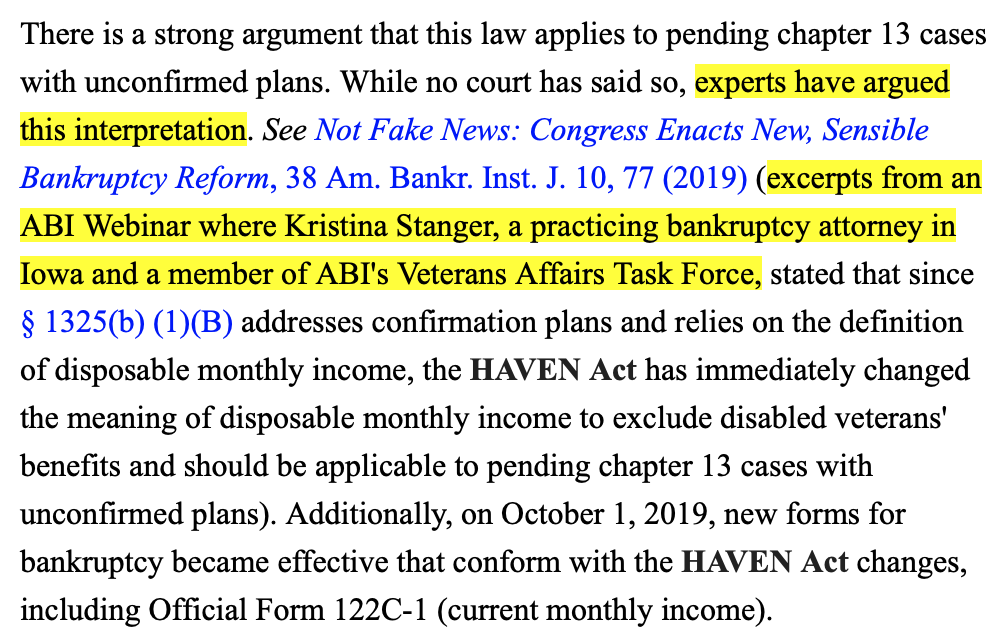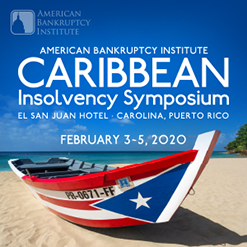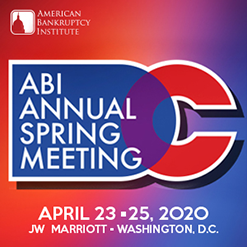| NEWS AND ANALYSIS |
|
The Coronavirus and Its Likely Impact on the Bankruptcy World: Eight Predictions from Two Restructuring Professionals
The coronavirus known as COVID-19 was unheard of in the U.S. a scant six or seven weeks ago, according to a special analysis written by Thomas J. Salerno of Stinson, LLP (Phoenix) and G. Neil Elsey of Avion Holdings, LLC (Scottsdale, Ariz.). Today, it dominates the world press, politics and polite (and less-than-polite) conversation, and is rapidly altering the way we work, play and interact — even the way we greet one another (with “elbow bumps” being an oddly acceptable way to greet a counterpart in a business setting). Our personal and professional routines are now materially impacted. Just this week, the American College of Bankruptcy announced the cancellation of its induction ceremonies in Washington, D.C., with scores of similar events being postponed or cancelled outright. Entire offices and schools are being closed. An entire country has imposed movement restrictions over its citizens (Italy’s 60 million inhabitants), with large numbers of other countries implementing wide-ranging gathering-place, travel and work restrictions. The coronavirus’s impact on capital markets, supply-chain disruption, hospitality and transportation is already seismic and being compared with the “economic shockwave” akin to the 9/11 economic ramifications. Salerno and Elsey proffer eight predictions as to how COVID-19 will alter the restructuring landscape in both the near term (and possibly longer). Click here to read the full analysis.
|
|

|
|
Coronavirus May Light Fuse on ‘Unexploded Bomb’ of Corporate Debt
A surge of risky borrowing by companies around the world leaves the global economy especially exposed to the potential costs of the outbreak, the New York Times reported. For years, analysts have warned that corporations around the planet were developing a dangerous addiction to debt. Interest rates were so low that borrowing money was essentially free, enticing companies to avail themselves with abandon. As the coronavirus outbreak spreads, halting factories from China to Italy, sending stock markets plunging and prompting fears of a worldwide recession, historic levels of corporate debt threaten to intensify the economic damage. Companies facing grave debt burdens may be forced to cut costs, laying off workers and scrapping investments, as they seek to avoid default. “We have been always saying that we are sitting on top of an unexploded bomb, but we don’t know what is going to trigger it,” said Emre Tiftik, director of Research for Global Policy Initiatives at the Institute of International Finance, a Washington-based financial industry trade group. “Can the coronavirus be a trigger? We don’t know. Maybe.” By the end of 2019, total outstanding debt among corporations other than financial institutions had surged to a record $13.5 trillion worldwide, according to a recent report by Serdar Çelik and Mats Isaksson for the Organization for Economic Cooperation and Development, the Paris-based research institution. That number has swelled as many companies have sold riskier bonds to finance expansions.

Miss the special abiLIVE webinar looking at supply-chain disruptions and other financial effects of the coronavirus? Watch a replay here.

|
|
European Travel Ban Delivers Another Blow to a Hobbled Airline Industry
Airline stocks tumbled today after President Trump prohibited most travelers from 26 European countries from visiting the U.S. for 30 days, the New York Times reported. Already reeling from a steep decline in bookings because of the coronavirus outbreak, the airlines now stand to lose millions of dollars in revenue from a halt to trans-Atlantic flights, which account for a big chunk of their international business. “Suspending travel on such a broad scale will create negative consequences across the economy,” said Alexandre de Juniac, the chief executive of the International Air Transport Association, an industry group. “Governments must recognize this and be ready to support” the industry. According to the association, about 200,000 flights carried passengers between the U.S. and 26 countries targeted in Trump’s order last year, averaging about 550 flights carrying 125,000 travelers per day. Over the next four weeks, the ban will affect more than 6,700 flights in each direction, according to an analysis by OAG, an aviation data provider.

|
|
Fed to Inject $1.5 Trillion in Bid to Prevent ‘Unusual Disruptions’ in Markets
The Federal Reserve said it would inject more than $1.5 trillion of temporary liquidity into Wall Street today and Friday to prevent ominous trading conditions from creating a sharper economic contraction, the Wall Street Journal reported. “These changes are being made to address highly unusual disruptions in Treasury financing markets associated with the coronavirus outbreak,” the New York Fed said in a statement today. The Fed said that it had made the changes for short-term funding markets following instructions from Chairman Jerome Powell, who was in consultation with the rate-setting Federal Open Market Committee. The moves suggest the Fed is shifting toward implementing the type of long-term asset purchases it deployed during and after the 2008 financial crisis, first to restore market functioning and later to spur a faster recovery in employment and output. (Subscription required.)

|
|
U.S. Experiences First Layoffs as a Result of the Coronavirus
The coronavirus outbreak is taking a deep toll on the U.S. economy, prompting hundreds of layoffs over the past week alone and halting a historic 11-year bull market in stocks, the Washington Post reported. Airlines, hotels, travel agencies and event companies have all been suffering, but interviews with more than two dozen firms and workers reveal that the pain is now translating into layoffs in a wider circle of industries, including a bakery and a chain restaurant. At the Port of Los Angeles, 145 drivers have been laid off and others have been sent home without pay as massive ships from China stopped arriving and work dried up. At travel agencies in Atlanta and Los Angeles, several workers lost their jobs as bookings evaporated. Christie Lites, a stage-lighting company in Orlando, laid off more than 100 of its 500 workers nationwide this past week and likely will lay off 150 more, according to chief executive Huntly Christie. Meanwhile a hotel in Seattle is closing an entire department, a former employee said, and as many as 50 people lost their jobs after the South by Southwest festival in Austin got canceled.

|
|
Consumer Financial Protection Bureau Proposes Whistleblower Award Program
The Consumer Financial Protection Bureau proposed a whistleblower program that would award tipsters who voluntarily provide original information on possible violations of consumer financial laws, the Wall Street Journal reported. The agency, which was created to protect consumers from abusive financial services practices, said on March 6 that it has submitted the proposal to the U.S. Congress and that the proposed program would incentivize employees to report wrongdoing, especially those related to fair-lending practices. We also want to incentivize whistleblowers to contact us if they believe their employer is not complying with the law,” Kathleen Kraninger, director of CFPB, said in a statement. The proposal would amend a provision of the Dodd-Frank Wall Street Reform and Consumer Protection Act of 2010, which created the bureau, and provide the authority to establish the whistleblower program. Under the proposed rules, tipsters who voluntarily provide information to the bureau are entitled to between 10% and 30% of monetary penalties if their tips result in an administrative proceeding or court action brought by the bureau and when the monetary penalties are more than $1 million. (Subscription required.)

|
|
Four New ABI Books Are Available for Purchase!
February has been a very busy month for ABI publications: There are four new books coming out!
Two recent “40 Under 40” honorees have edited new digital editions of our annual “Best of ABI” books. Charissa Potts (Freedom Law, PC) edited The Best of ABI 2019: The Year in Consumer Bankruptcy, which focuses on such timely topics as student loan discharge, chapter 7 practice trends and ethical dilemmas faced by consumer practitioners, and chapter 13 plan confirmation and discharge issues, among other topics. Lindsi Weber (Polsinelli) edited The Best of ABI 2019: The Year in Business Bankruptcy, which covers the new Small Business Reorganization Act, health care, international issues, intellectual property, KERPs, chapter 11 and make-whole issues, executory contracts, and emerging trends such as artificial intelligence, as well as other topics.
Thomas J. Salerno, along with a team of writers from Stinson LLP, has updated Pre-Bankruptcy Planning for the Commercial Reorganization. As the authors note in this third edition of the popular title, “Pre-bankruptcy planning for the commercial chapter 11 reorganization can be broken down conceptually into four distinct (although interrelated) categories, which are set forth in no particular order of priority: (1) preparation of management, key employees and exit strategy; (2) business preparation; (3) legal preparation; and (4) tax preparation.” This update is an invaluable guide for CFOs, General Counsel, and tax advisors, as well as, of course, for practitioners who represent them in going through a reorganization.
Finally, Susan N.K. Gummow (Foran Glennon) has updated the Bankruptcy and Insurance Law Manual. The fourth edition has been updated to include the latest issues confronting bankruptcy and insurance jurisprudence, including jurisdictional issues in light of the Supreme Court’s decision in Stern v. Marshall, the rise of sexual abuse-related mass tort bankruptcy proceedings in the aftermath of state-enacted “window” legislation, and the use of the Bankruptcy Code to effectuate a policy buy-back as an efficient means of resolving insured/insurer disputes. The Manual also updates and clarifies key insurance and bankruptcy concepts, such as the binding nature of proof-of-claim litigation, the rights and obligations under an insurance policy containing a self-insured retention where the insured is bankrupt, and the function and role of the creditors’ committee during an insured’s bankruptcy case.
All these titles, along with many other publications relating to all aspects of bankruptcy and insolvency, are available at store.abi.org (remember to log in with your ABI credentials to secure member pricing).
|
|
Sign up Today to Receive Rochelle’s Daily Wire by E-mail!
Have you signed up for Rochelle’s Daily Wire in the ABI Newsroom? Receive Bill Rochelle’s exclusive perspectives and analyses of important case decisions via e-mail!
Tap into Rochelle’s Daily Wire via the ABI Newsroom and Twitter!
|
|
|
|
| BLOG EXCHANGE |
|
New on ABI’s Bankruptcy Blog Exchange: The Solvent Debtor and Post-Petition Interest on Unsecured Claims
It’s a rare thing, but it happens: A profoundly insolvent debtor files bankruptcy, only to become solvent thereafter and able to pay all debts in full. Read a recent blog post discussing this infrequent phenomenon.
To read more on this blog and all others on the ABI Blog Exchange, please click here.
|
|
|
|




















